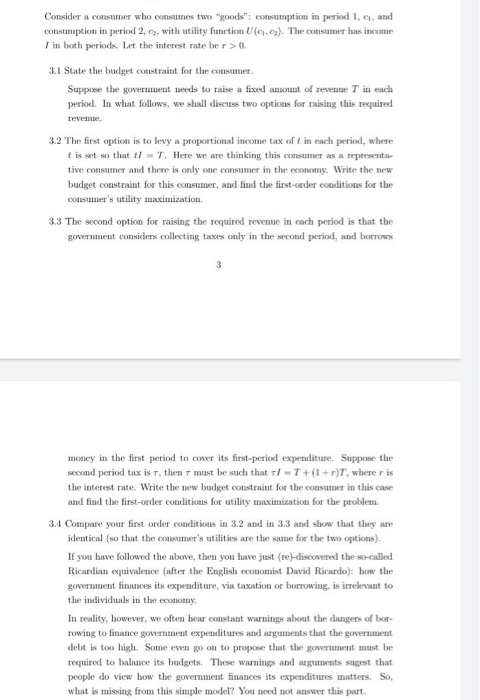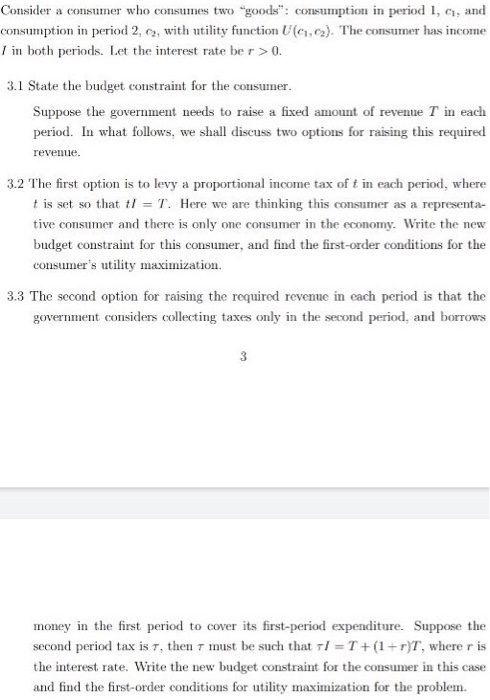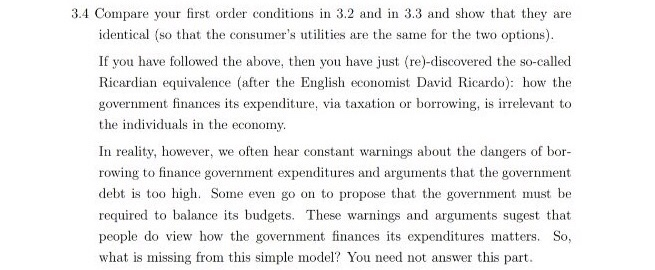Question
Consider a consumer who consumes two goods: consumption in period 1, c1, and consumption in period 2, c2, with utility function U(c1, c2). The consumer






Consider a consumer who consumes two goods: consumption in period 1, c1, and consumption in period 2, c2, with utility function U(c1, c2). The consumer has income I in both periods. Let the interest rate be r> 0.
3.1 State the budget constraint for the consumer. Suppose the government needs to raise a fixed amount of revenue T in each period. In what follows, we shall discuss two options for raising this required revenue.
3.2 The first option is to levy a proportional income tax of t in each period, where t is set so that tI = T. Here we are thinking this consumer as a representative consumer and there is only one consumer in the economy. Write the new budget constraint for this consumer, and find the first-order conditions for the consumers utility maximization.
3.3 The second option for raising the required revenue in each period is that the government considers collecting taxes only in the second period, and borrows money in the first period to cover its first-period expenditure. Suppose the second period tax is , then must be such that I = T + (1 + r)T, where r is the interest rate. Write the new budget constraint for the consumer in this case and find the first-order conditions for utility maximization for the problem.
3.4 Compare your first order conditions in 3.2 and in 3.3 and show that they are identical (so that the consumers utilities are the same for the two options). If you have followed the above, then you have just (re)-discovered the so-called Ricardian equivalence (after the English economist David Ricardo): how the government finances its expenditure, via taxation or borrowing, is irrelevant to the individuals in the economy. In reality, however, we often hear constant warnings about the dangers of borrowing to finance government expenditures and arguments that the government debt is too high. Some even go on to propose that the government must be required to balance its budgets. These warnings and arguments sugest that people do view how the government finances its expenditures matters. So,what is missing from this simple model? You need not answer this part.
Consider a consumer who consumes two "goods": consumption in period 1, C, and consumption in period 2, 3, with utility function (ac). The consumer has income 1 in both periods. Let the interest rate ber >0. 3.1 State the budget constraint for the consumer. Suppose the government needs to raise a fixed amount of revenue Tin each period. In what follows, we shall discuss two options for raising this required revene. 3.2 The first option is to levy a proportional income tax of t in each period, where t is set so that t1 - T. Here we are thinking this consumer as a representa tive consumer and there is only one consumer in the economy. Write the new budget constraint for this consumer, and find the first-order conditions for the consumer's utility maximization 3.3 The second option for raising the required revenue in each period is that the government considers collecting taxess only in the second period, and borrows 3 money in the first period to cover its first-period expenditure. Suppose the second period tax is 7, then 7 must be such that I -T + (1 + r), wherer is the interest rate. Write the new budget constraint for the consumer in this case and find the first-order conditions for utility maximization for the problem. 3.1 Compare your first order conditions in 3.2 and in 3.3 and show that they are identical (so that the consumer's utilities are the same for the two options) If you have followed the above, then you have just (re)-discovered the so-called Ricardian equivalence (after the English economist David Ricardo): how the government finances its expenditure, via taxation or borrowing, is irrelevant to the individuals in the economy. In reality, however, we often hear constant warnings about the dangers of bor- rowing to finance government expenditures and arguments that the government debt is too high. Some even go on to propose that the government must be required to balance its budgets. These warnings and arguments sugest that people do view how the government finances its expenditures matters. So, what is missing from this simple model? You need not answer this part. Consider a consumer who consumes two "goods: consumption in period 1, q, and consumption in period 2, 3, with utility function U (C1,C2). The consumer has income I in both periods. Let the interest rate be r >0. 3.1 State the budget constraint for the consumer. Suppose the government needs to raise a fixed amount of revenue T in each period. In what follows, we shall discuss two options for raising this required revenue. 3.2 The first option is to levy a proportional income tax of t in each period, where t is set so that t1 = T. Here we are thinking this consumer as a representa- tive consumer and there is only one consumer in the economy. Write the new budget constraint for this consumer, and find the first-order conditions for the consumer's utility maximization. 3.3 The second option for raising the required revenue in each period is that the government considers collecting taxes only in the second period, and borrows 3 money in the first period to cover its first-period expenditure. Suppose the second period tax is 7, then must be such that I =T +(1+r)T, where r is the interest rate. Write the new budget constraint for the consumer in this case and find the first-order conditions for utility maximization for the problem. 3.4 Compare your first order conditions in 3.2 and in 3.3 and show that they are identical (so that the consumer's utilities are the same for the two options). If you have followed the above, then you have just (re)-discovered the so-called Ricardian equivalence (after the English economist David Ricardo): how the government finances its expenditure, via taxation or borrowing, is irrelevant to the individuals in the economy In reality, however, we often hear constant warnings about the dangers of bor- rowing to finance government expenditures and arguments that the government debt is too high. Some even go on to propose that the government must be required to balance its budgets. These warnings and arguments sugest that people do view how the government finances its expenditures matters. So, what is missing from this simple model? You need not answer this part. Consider a consumer who consumes two "goods: consumption in period 1, C1, and consumption in period 2, C2, with utility function U(C1, C2). The consumer has income I in both periods. Let the interest rate be r > 0. 3.1 State the budget constraint for the consumer. Suppose the government needs to raise a fixed amount of revenue T in each period. In what follows, we shall discuss two options for raising this required revenue. 3.2 The first option is to levy a proportional income tax of t in each period, where t is set so that tI = T. Here we are thinking this consumer as a representa- tive consumer and there is only one consumer in the economy. Write the new budget constraint for this consumer, and find the first-order conditions for the consumer's utility maximization. Consider a consumer who consumes two "goods: consumption in period 1, C1, and consumption in period 2, C2, with utility function U(C1, C2). The consumer has income I in both periods. Let the interest rate be r > 0. 3.1 State the budget constraint for the consumer. Suppose the government needs to raise a fixed amount of revenue T in each period. In what follows, we shall discuss two options for raising this required revenue. 3.2 The first option is to levy a proportional income tax of t in each period, where t is set so that tI = T. Here we are thinking this consumer as a representa- tive consumer and there is only one consumer in the economy. Write the new budget constraint for this consumer, and find the first-order conditions for the consumer's utility maximization. Consider a consumer who consumes two "goods: consumption in period 1, C1, and consumption in period 2, C2, with utility function U(C1, C2). The consumer has income I in both periods. Let the interest rate be r > 0. 3.1 State the budget constraint for the consumer. Suppose the government needs to raise a fixed amount of revenue T in each period. In what follows, we shall discuss two options for raising this required revenue. 3.2 The first option is to levy a proportional income tax of t in each period, where t is set so that tI = T. Here we are thinking this consumer as a representa- tive consumer and there is only one consumer in the economy. Write the new budget constraint for this consumer, and find the first-order conditions for the consumer's utility maximization. Consider a consumer who consumes two "goods": consumption in period 1, C, and consumption in period 2, 3, with utility function (ac). The consumer has income 1 in both periods. Let the interest rate ber >0. 3.1 State the budget constraint for the consumer. Suppose the government needs to raise a fixed amount of revenue Tin each period. In what follows, we shall discuss two options for raising this required revene. 3.2 The first option is to levy a proportional income tax of t in each period, where t is set so that t1 - T. Here we are thinking this consumer as a representa tive consumer and there is only one consumer in the economy. Write the new budget constraint for this consumer, and find the first-order conditions for the consumer's utility maximization 3.3 The second option for raising the required revenue in each period is that the government considers collecting taxess only in the second period, and borrows 3 money in the first period to cover its first-period expenditure. Suppose the second period tax is 7, then 7 must be such that I -T + (1 + r), wherer is the interest rate. Write the new budget constraint for the consumer in this case and find the first-order conditions for utility maximization for the problem. 3.1 Compare your first order conditions in 3.2 and in 3.3 and show that they are identical (so that the consumer's utilities are the same for the two options) If you have followed the above, then you have just (re)-discovered the so-called Ricardian equivalence (after the English economist David Ricardo): how the government finances its expenditure, via taxation or borrowing, is irrelevant to the individuals in the economy. In reality, however, we often hear constant warnings about the dangers of bor- rowing to finance government expenditures and arguments that the government debt is too high. Some even go on to propose that the government must be required to balance its budgets. These warnings and arguments sugest that people do view how the government finances its expenditures matters. So, what is missing from this simple model? You need not answer this part. Consider a consumer who consumes two "goods: consumption in period 1, q, and consumption in period 2, 3, with utility function U (C1,C2). The consumer has income I in both periods. Let the interest rate be r >0. 3.1 State the budget constraint for the consumer. Suppose the government needs to raise a fixed amount of revenue T in each period. In what follows, we shall discuss two options for raising this required revenue. 3.2 The first option is to levy a proportional income tax of t in each period, where t is set so that t1 = T. Here we are thinking this consumer as a representa- tive consumer and there is only one consumer in the economy. Write the new budget constraint for this consumer, and find the first-order conditions for the consumer's utility maximization. 3.3 The second option for raising the required revenue in each period is that the government considers collecting taxes only in the second period, and borrows 3 money in the first period to cover its first-period expenditure. Suppose the second period tax is 7, then must be such that I =T +(1+r)T, where r is the interest rate. Write the new budget constraint for the consumer in this case and find the first-order conditions for utility maximization for the problem. 3.4 Compare your first order conditions in 3.2 and in 3.3 and show that they are identical (so that the consumer's utilities are the same for the two options). If you have followed the above, then you have just (re)-discovered the so-called Ricardian equivalence (after the English economist David Ricardo): how the government finances its expenditure, via taxation or borrowing, is irrelevant to the individuals in the economy In reality, however, we often hear constant warnings about the dangers of bor- rowing to finance government expenditures and arguments that the government debt is too high. Some even go on to propose that the government must be required to balance its budgets. These warnings and arguments sugest that people do view how the government finances its expenditures matters. So, what is missing from this simple model? You need not answer this part. Consider a consumer who consumes two "goods: consumption in period 1, C1, and consumption in period 2, C2, with utility function U(C1, C2). The consumer has income I in both periods. Let the interest rate be r > 0. 3.1 State the budget constraint for the consumer. Suppose the government needs to raise a fixed amount of revenue T in each period. In what follows, we shall discuss two options for raising this required revenue. 3.2 The first option is to levy a proportional income tax of t in each period, where t is set so that tI = T. Here we are thinking this consumer as a representa- tive consumer and there is only one consumer in the economy. Write the new budget constraint for this consumer, and find the first-order conditions for the consumer's utility maximization. Consider a consumer who consumes two "goods: consumption in period 1, C1, and consumption in period 2, C2, with utility function U(C1, C2). The consumer has income I in both periods. Let the interest rate be r > 0. 3.1 State the budget constraint for the consumer. Suppose the government needs to raise a fixed amount of revenue T in each period. In what follows, we shall discuss two options for raising this required revenue. 3.2 The first option is to levy a proportional income tax of t in each period, where t is set so that tI = T. Here we are thinking this consumer as a representa- tive consumer and there is only one consumer in the economy. Write the new budget constraint for this consumer, and find the first-order conditions for the consumer's utility maximization. Consider a consumer who consumes two "goods: consumption in period 1, C1, and consumption in period 2, C2, with utility function U(C1, C2). The consumer has income I in both periods. Let the interest rate be r > 0. 3.1 State the budget constraint for the consumer. Suppose the government needs to raise a fixed amount of revenue T in each period. In what follows, we shall discuss two options for raising this required revenue. 3.2 The first option is to levy a proportional income tax of t in each period, where t is set so that tI = T. Here we are thinking this consumer as a representa- tive consumer and there is only one consumer in the economy. Write the new budget constraint for this consumer, and find the first-order conditions for the consumer's utility maximizationStep by Step Solution
There are 3 Steps involved in it
Step: 1

Get Instant Access to Expert-Tailored Solutions
See step-by-step solutions with expert insights and AI powered tools for academic success
Step: 2

Step: 3

Ace Your Homework with AI
Get the answers you need in no time with our AI-driven, step-by-step assistance
Get Started


